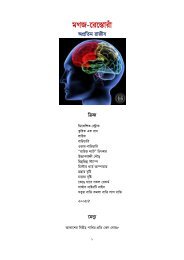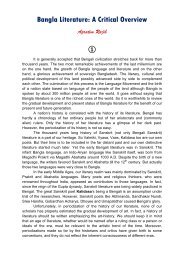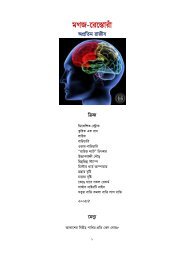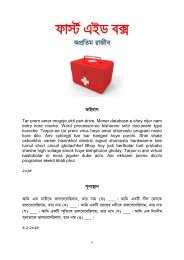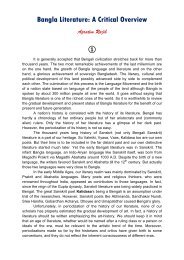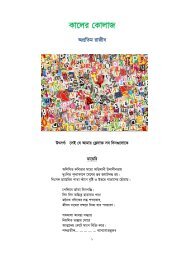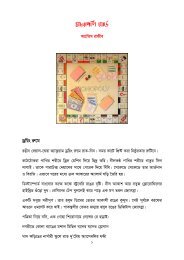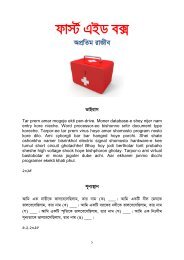BLiterature-Apratim
Create successful ePaper yourself
Turn your PDF publications into a flip-book with our unique Google optimized e-Paper software.
42<br />
Dhatri-Devata, Gana-Devata and Panchagram are called an epic trilogy in<br />
total set in the region of Birbhum. Tarashankar tells us the story of Indian mass<br />
uprising in this trilogy.<br />
Jalsha-Ghar is a novella based on the historical fact of the defeat of feudal<br />
aristocracy to newly emerged bourgeoisie.<br />
Kalindi is a fiction of two political activists from an inhabitance of the Santals –<br />
one of them is a Marxist and the other one, a follower of Gandhi. At the end, both of<br />
them embrace imprisonment and the writer seems to be more sympathetic to the first<br />
one.<br />
Kavi is a tale of a proletariat folk poet who represents the all times Bengali<br />
poetasters.<br />
In some other works, he questions human moral judgment like Tolstoy.<br />
Saptapadi (Seven Circles) and Bicharak (The Judge) are such two works.<br />
Tarashankar followed Mahatma Gandhi’s philosophies surrounding nonviolence.<br />
In his early life, he was a political activist of the Indian National Congress<br />
party. Sometimes he was even imprisoned and persecuted. He joined the anti-<br />
Fascist movement and later became a member of independent India’s parliament.<br />
In literature too, Tarashankar did not follow Marx like Manik. He was a bearer<br />
of an Indian leader’s unique philosophies. Rather he succeeded in the perfection of<br />
artistic achievement and reached the height of fictional art.<br />
Jibanananda Das (1899-1954)<br />
Jibanananda is called the ‘Nilkantha (i.e. Shiva) of endangered humanity’. He<br />
drank the death-poison of man’s inhuman and heartless conscience. His exuberance<br />
and high aim of poetical art surpasses all other poets of the High Modern era<br />
including Yeats and Eliot.<br />
Dhushar Pandulipi (The Gray Manuscript) is his first original attempt. In this<br />
anthology his first encounter with the filthiness of life and the world is revealed. The<br />
book starts with “Nirjan Sakshar” (“The Desolate Sign”) which is a handsome piece<br />
of work by any poet newly entered into the post-war modern world. “Campe” (“At the<br />
Camp”) is the most significant poem of this anthology. Here the poet says we all are<br />
like wild dear murdered by this cruel world because of our desperation and tire of<br />
love. He says –<br />
“We go on living with the valor of love – its longings – dreams – nursing our wounds,<br />
encountering hate – death;<br />
Don’t we?”<br />
(Translated by Fakrul Alam)<br />
In “Pakhira” (“The Birds”) he wishes if we had the taste of simplicity of life and love<br />
like the flying birds. “Mrityur Agey” (“Before Death”) is another memorable piece of<br />
poem. It was praised even by the aged Tagore for its picturesque exposition of<br />
natural image.<br />
Banalata Sen is one of his most popular poetical works. It starts with the<br />
entitling poem which is famed for its romantic exposition. It bears the message that




